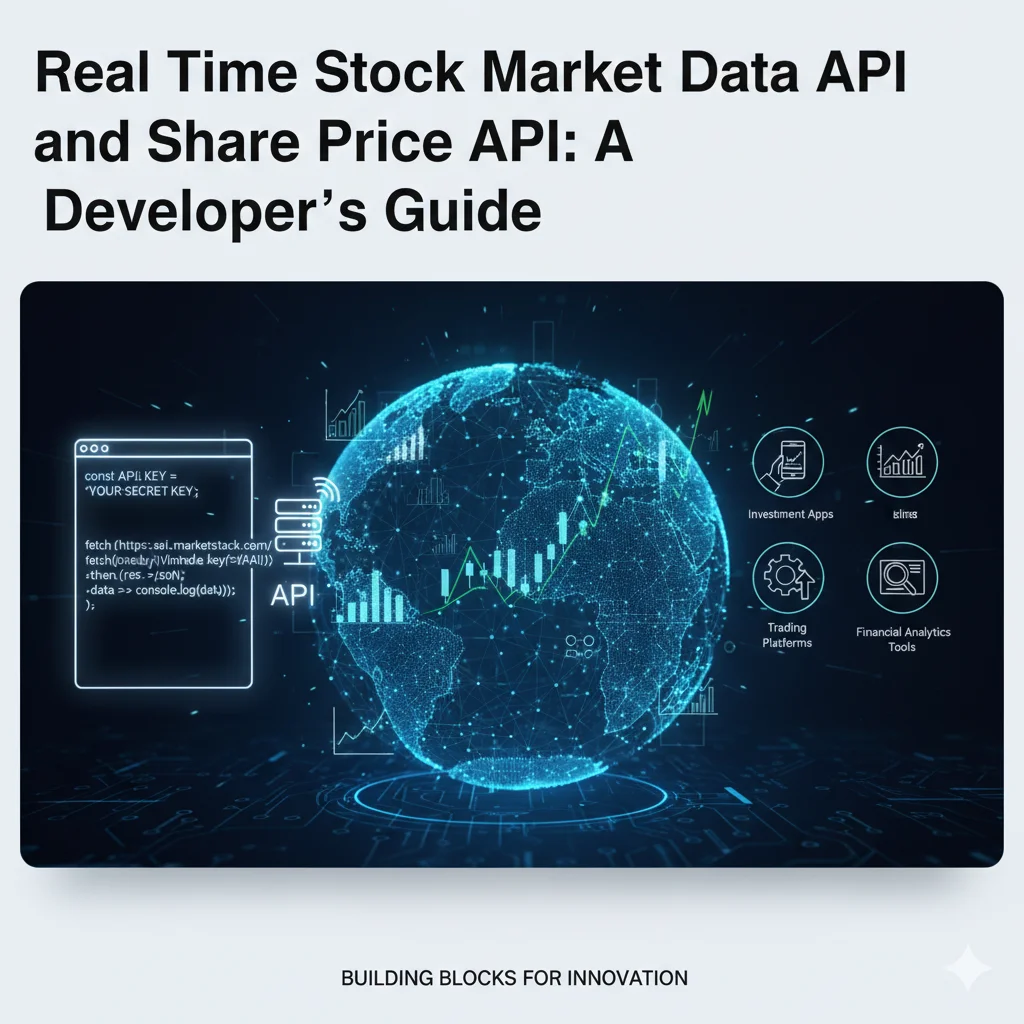Building financial applications today requires fast, accurate, and reliable data. Whether you’re designing a trading bot, a portfolio tracker, or an analytics dashboard, the foundation of your project often rests on a real time stock market data API and a share price API. These tools give developers instant access to stock prices, market movements, and historical context without managing large data sets manually.
In this guide, we’ll cover everything you need to know, from understanding what these APIs do, to integrating them into your project, to following best practices that ensure performance and scalability.
Introduction to Real Time Stock Market Data APIs
A real time stock market data API provides developers with up-to-the-second stock prices and market activity. Instead of waiting for delayed feeds or parsing complex exchange data directly, you can pull live prices, bid/ask spreads, and volume information with a single API request.
Why Developers Need Real-Time Data
-
Trading Platforms: Power order execution engines and live dashboards.
-
Investment Apps: Deliver accurate stock prices to retail users.
-
Financial Analytics Tools: Run calculations and generate insights with fresh market data.
-
Research Applications: Compare live conditions against historical data for better insights.
In today’s fast-moving markets, even a few seconds of delay can affect decision-making. That’s why developers rely on APIs that are accurate, fast, and scalable.
Overview of Share Price APIs
A share price API focuses specifically on delivering current and historical stock prices. While broader stock market APIs may include indices, commodities, or forex, a share price API typically zeroes in on:
-
Live stock prices for individual companies
-
Daily open, high, low, close (OHLC) values
-
Adjusted historical prices for dividends or stock splits
-
Intraday intervals (1-minute, 5-minute, or hourly data)
Key Applications of Share Price APIs
-
Portfolio Tracking: Displaying up-to-date values of holdings.
-
Stock Tickers: Embedding scrolling or static share price widgets in apps.
-
Backtesting: Evaluating strategies using historical share price data.
-
Alerts and Notifications: Sending push updates when share prices move beyond thresholds.
For developers, share price APIs are building blocks that allow apps to speak the same language as the stock exchange without heavy lifting.
Comparison of Popular Real Time Stock Market Data APIs
When selecting an API, it’s essential to balance features, pricing, and limitations. Here’s an overview of common providers in the market:
| API Provider | Key Features | Pricing | Limitations |
| Real-time, intraday, and historical stock data across 70+ global exchanges. JSON-based responses. | Free tier available; paid plans scale with request volume. | Free tier may limit request frequency. | |
| Alpha Vantage | Time series data, share price APIs, and technical indicators. Supports intraday and daily data. | Free access with limited requests; premium tiers available. | Rate limits on free accounts can slow development. |
| Yahoo Finance API (Unofficial) | Wide coverage, simple share price data, historical datasets. | Free access via community wrappers. | No official support; data reliability varies. |
| IEX Cloud | Real-time U.S. stock prices, deep market data, and financial reports. | Pay-as-you-go model; free tier with limited access. | Focused mainly on U.S. markets. |
| Polygon.io | Advanced real-time feeds, tick-level data, and streaming WebSocket support. | Subscription-based pricing, from developer to enterprise plans. | Costs rise for low-latency, high-frequency data. |
The right choice depends on your project requirements. For lightweight apps, free tiers are sufficient. For trading systems or professional dashboards, premium APIs with guaranteed uptime and support are better.
Step-by-Step Guide to Integrating a Real Time Stock Market Data API
Integrating a real time stock market data API is straightforward for most developers. Here’s a step-by-step breakdown:
Step 1: Sign Up and Get an API Key
Register with your chosen provider to receive an API key. This key authenticates your requests.
Step 2: Review the Documentation
Check the available endpoints, query parameters, and response formats. For example, you might find endpoints like:
GET /realtime?symbols=AAPL,GOOGL
Step 3: Make Your First Request
In JavaScript (Node.js), a sample fetch request could look like this:
const fetch = require("node-fetch");
const API_KEY = "your_api_key_here";
const symbol = "AAPL";
fetch(`https://api.marketstack.com/v1/intraday?access_key=${API_KEY}&symbols=${symbol}`)
.then(response => response.json())
.then(data => console.log(data));
Step 4: Parse the Response
Responses usually return JSON with fields like:
{
"symbol": "AAPL",
"price": 178.45,
"timestamp": "2025-09-26T10:15:00Z"
}
Step 5: Integrate Into Your Application
-
For dashboards: Display the share price in charts and widgets.
-
For trading apps: Feed the price into algorithms.
-
For alerts: Trigger notifications based on conditions.
Step 6: Test and Optimize
Simulate different request loads and ensure you handle API rate limits effectively.
Best Practices for Optimizing Share Price APIs in Applications
To ensure smooth performance and cost efficiency, follow these practices:
-
Cache Data Whenever Possible
Store frequently requested historical or intraday data to reduce API calls. -
Respect Rate Limits
Implement throttling and retry mechanisms to avoid hitting provider limits. -
Use WebSockets for Streaming
Instead of repeatedly polling the API, use WebSocket endpoints for continuous real-time updates. -
Secure API Keys
Never hardcode keys in source files, use environment variables or secret managers. -
Normalize Data Across Sources
If combining APIs, standardize timestamp formats and currencies to maintain consistency. -
Monitor API Latency
Keep track of how quickly responses are delivered, especially if you’re powering trading or analytics tools. -
Start with Free, Scale with Paid
Use free tiers for testing and development. Once your app scales, upgrade to paid plans for stability and support.
FAQs
1. What is the difference between a real time stock market data API and a share price API?
A real time stock market data API delivers live market activity, including bids, asks, and volume. A share price API focuses on current and historical stock prices for individual companies.
2. Are these APIs free to use?
Some providers offer free tiers with limited requests per day. For advanced features, low-latency data, or larger volumes, you’ll need a paid plan.
3. How accurate are free APIs compared to paid ones?
Free APIs are often delayed or limited in frequency. Paid APIs generally provide faster, more reliable, and exchange-backed data.
4. Can I use these APIs to build a trading app?
Yes, but you must ensure compliance with financial regulations in your region. Real-time APIs are widely used in both retail and professional trading platforms.
5. What’s the best way to handle large request volumes?
Batch requests, implement caching, and use WebSockets for continuous updates instead of sending frequent individual requests.
6. Do these APIs support global markets?
Yes, many providers cover multiple exchanges worldwide, though some specialize in specific regions (e.g., IEX Cloud for U.S. stocks).
7. How can I protect my API key in production?
Store keys in environment variables or a secrets manager, and never expose them in client-side code.
For developers working in finance, real time stock market data APIs and share price APIs are essential tools. They simplify access to market information, enabling you to focus on building robust applications rather than managing raw datasets.
From powering trading apps to running portfolio trackers, these APIs help you deliver accurate, timely, and engaging experiences. By following best practices and choosing the right provider, you can create applications that scale effectively while staying cost-efficient.







